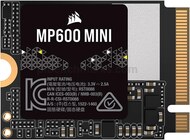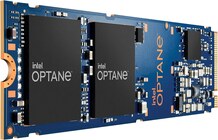
Pi Benchmarks has officially passed over 100,000 tests submitted! The site’s earliest tests started in early 2019 giving us over 5 years worth of real world testing by the single board computer (SBC) community across different boards.
Today we are going to cover the fastest combinations of hardware on the Raspberry Pi 5 to achieve the absolute highest storage scores and performance possible (and the top result *will* surprise you).
Let’s get started!
Best SSDs
Top SSD Result #3 – Corsair MP600 Mini
| Rank: | #3 | ||||||
| Popularity: | #84 | ||||||
| # Tests: | 182 | ||||||
| Brand: | Corsair MP600 Mini | ||||||
 | |||||||
| |||||||
This is a very practical drive choice for the Raspberry Pi 5. It is meant to go into compact devices and is designed for use with things like the Steam Deck, Microsoft Surface, etc.
The drive’s technical size is a M.2 2230 (as opposed to the standard / full size of M.2 2280). This is also a popular drive choice for alternative boards such as the Orange Pi 5.
The drive is also a PCIe gen 4.0 but lists backwards compatibility as a primary design choice (and it does indeed work very well in backwards compatible mode with devices like the Pi). This is a highly recommended drive.
Top SSD Result #2 – Corsair MP600 GS
| Rank: | #2 | ||||||
| Popularity: | #172 | ||||||
| # Tests: | 86 | ||||||
| Brand: | Corsair MP600 GS | ||||||
 | |||||||
| |||||||
This is another very practical drive choice for the Raspberry Pi 5. It is a bigger, full size drive but you will save about $20 (at time of writing) over the MP600 Mini version.
The GS version is a bit of a budget version as the MP600 non-GS version can do 4950 MB/s while the GS version does 4800 MB/s. This difference is absolutely negligible so if you aren’t going to get the MP600 mini version I would go with the GS. The Raspberry Pi 5 can’t take advantage of the faster PCIe 4.0 speeds anyway so there will be no practical difference on the device.
The drive’s average scores are very close. Don’t be surprised if you are reading this article 6 months after publishing if they’ve flipped slightly on the charts!
Top SSD Result #1 – Intel Optane P1600X
So far the list has been pretty straightforward. It’s dominated by the newest models of PCIe 4.0/5.0 drives which is exactly what we would expect. Until now.
Ladies and gentleman, the fastest Raspberry Pi 5 storage device in the entire world is: the Intel Optane P1600X?! What?!!
| Rank: | #1 | ||||||
| Popularity: | #80 | ||||||
| # Tests: | 186 | ||||||
| Brand: | Intel Optane P1600X Series | ||||||
 | |||||||
| |||||||
The ingenuity and resourcefulness of the Raspberry Pi and single board computer community never cease to amaze me. While this is a surprising result it actually makes perfect sense. To understand why we need to understand what Intel Optane is (or was).
What Is / Was Intel Optane?
Intel Optane was a attempt to create and promote a tier of memory that’s a little slower than RAM but had the virtues of persistence and high IOPS. It was discontinued in July of 2022.
In other words, it was meant to be essentially a cache that is faster than your disk but slower than your RAM. It was designed to bridge the gap between disk and RAM (and thus has some characteristics of both).
This replacement technology needed to have extremely fast random read/write speeds to be effective. To accomplish this Intel and Micron worked together to make a new type of non-volatile RAM called 3D XPoint (non-volatile just means when you reboot the computer or it loses power the contents aren’t lost like they are with regular memory).
3D XPoint technology is the reason that the Intel Optane P1600X is absolutely stomping brand new PCIe 4.0/5.0 SSDs. This drive is *not* a traditional SSD. It’s actually a special type of RAM that doesn’t lose it’s contents when the computer is shut down and performs *extremely* well on random read/write performance (PERFECT for an operating system).
If it’s so fast on the Raspberry Pi should I use Optane in my PC?
Nope. The reason these drives are so fast with the Raspberry Pi 5 is because you can’t take advantage of PCIe 4.0/5.0 with a Pi at this time. The throughput of PCIe 4.0/5.0 is much higher than any of these Intel Optane drives are capable of.
In other words the only reason that these are the fastest drives for the Raspberry Pi is because the Raspberry Pi 5 can’t utilize the newer higher versions of PCIe (but a modern computer can). You will be better off with a PCIe 4.0/5.0 gen drive in a modern computer than you will with these Optane drives. Intel Optane drives are only PCIe gen 3.0. There are no PCIe 4.0 or 5.0 Optane drives and it’s overwhelmingly likely there never will be as the technology is discontinued.
Because of this PCIe version limitation of the Raspberry Pi the extremely high random read/write performance of the older Intel Optane drives make it the fastest drive in the world you can use on a Raspberry Pi 5.
The tradeoffs simply are working in the Pis favor with Intel Optane creating this really weird (and temporary) dynamic where if you are still stuck on PCIe 3.0 or lower the special memory used in this SSD is faster than anything else (including sticking a PCIe 4.0 or 5.0 drive into a Pi which can’t utilize the newer technology and throughput).
Should I get Optane for my Raspberry Pi 5?
Probably not really unless you find ones for a really reasonable price still out there. It’s completely sold out on all major sites like Amazon, etc.
Unless you have the most extreme of performance requirements (you’ll know if it applies to you) you’d probably be better off buying a modern PCIe 4.0/5.0 drive even for the Raspberry Pi.
If you do have one laying around or find a cheap listing though then yes. As I’ve laid out there is no faster choice you could make to get extremely fast random read/write performance. The Optane drives are generally not very large and capacities range from 16GB to something like 108GB
Best Adapters
This section will be a little bit easy to cover. Let’s start with the king:
Top Performing

Raspberry Pi 5 Mini PC Case: Enhance your Raspberry Pi 5 with the Pironman 5, crafted from durable aluminum with advanced cooling, NVMe M.2 SSD support, OLED display, customizable RGB lighting, dual standard HDMI ports, and a secure power switch. Assembly is simple with a clear, step-by-step guide, ensuring easy setup. Ideal for NAS, Home Assistant, Media, and Game Centers (Raspberry Pi NOT Included)
Expandable NVMe M.2 SSD Slot: Enhance your Raspberry Pi 5’s performance with the easy-to-install NVMe M.2 SSD slot, compatible with multiple sizes (2230, 2242, 2260, 2280). Enjoy increased storage capacity and faster system response, with smooth compatibility and reliable performance
Links: Amazon.com*, AliExpress.com*
This thing is absurd. I’ve been covering Raspberry Pis for a long time and this may be one of the most over the top accessories I’ve ever seen. RGB lighting and an OLED display?!
There is no arguing with the performance though. Many of the top spots on pibenchmarks.com specifically mention using this enclosure / adapter for their NVMe / storage performance.
Budget Choices
The X1001 and X1002 adapters for the Raspberry Pi generally range from $12-$15 or so and are much more budget friendly than the Pironman 5 case. They still have several results on the #1 top results page that used this set of adapters.

Compatibility: Pi 5 PCIe M.2 HAT only compatible with Raspberry Pi 5 2GB/4GB/8GB SBC, Model: X1001
M2 Key-M NVMe SSD Supported: Support M.2 KEY-M NVMe SSD 2230/2242/2260/2280 length installation; Comes with SSD copper pillar for 2230/2242/2260
Power the X1001 shield directly from the FFC PCIe ribbon; Use the PD 27W power adapter for Raspberry Pi 5
Links: Amazon.com*

Compatibility: Pi 5 PCIe M.2 HAT Bottom only for Raspberry Pi 5 2GB/4GB/8GB SBC; model: X1002; matching metal case is P580 M.2 Key-M NVMe SSD Supported:
Compatible with M.2 Key-M NVMe SSD 2280/2260/2242/2230 length (SSD is not included)NVMe SSD
How to Power: Can power the X1002 shield directly from the FFC PCIe ribbon (providing maximum 5W of continuous power), use the PD 27W power supply for Raspberry Pi 5
Links: Amazon.com*
Testing Your Own Storage
Running the benchmark is extremely easy. Run the following command on your Pi:
sudo curl https://raw.githubusercontent.com/TheRemote/PiBenchmarks/master/Storage.sh | sudo bash





James,
I appreciate your sharing of knowledge and meticulous approach to technology. I have been using the Pi Benchmark site and test for my journey into SBCs and associated storage. A few devices, such as the Hardkernel Odroid C4 (eMMC) and Firewalla Blue, succeeded in running the benchmark; however, I could not find them when querying the site. ! Be well, and thanks again for all you do to support the community.
Kind Regards,
Andrew Chandler
Hey Andrew,
Thanks for taking the benchmark! I’m a bit behind on adding new models but you should still see the benchmark on the site somewhere (unless it was using storage that hasn’t been identified yet at all).
I will take a look and see if I can get the models added!
I’m so happy to see this post =)
Does the benchmark tool just test the system drive or can it be used for external storage as well?
I’m wondering how well/poorly my fancy Samsung T7 and T7 Shield perform when attached to my rather modest Pi 4B via a single USB adapter
Hey Anthony,
That’s awesome! Judging from this you should still do pretty well. The high-grade and high-speed storage on there does help even on the Raspberry Pi 4.
In other words you will hit the bandwidth limit of USB 3.0 but because the memory and storage is a higher grade in the Samsung T7 / T7 Shield you still will outperform most drives!